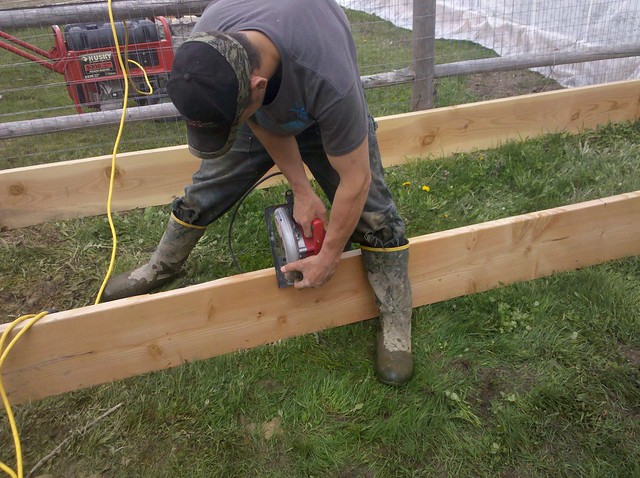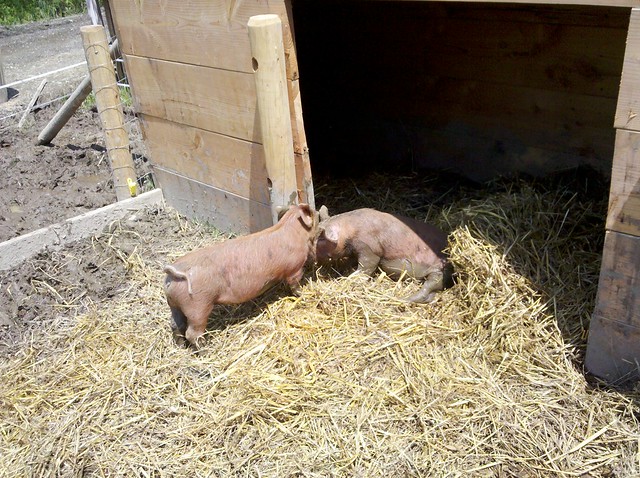Here is a simple pig pen design we had built one year when we decided to get some piglets at the last moment. A friend of mine raises them and had asked us earlier in the season if we would be interested in some.
I told him we would and totally forgot about it until one day in May he called and asked if we still wanted them. I said yep, when would they be ready? He replied two days, well I guess I better start working on a pig pen!
1So I picked up some cedar fencing.

2And did a quick mock up.

3We dug our first hole.

4Using a rail as a guide we dug the second.

5And continued working around the perimeter.

29I miss those guys.

If you are thinking of raising pigs; do it. They are probably our favorite animals; they are extremely intelligent and can be very affectionate with daily interaction. Within a month they were coming when called.
Storey’s Guide to Raising Pigs: 3rd Edition
The trusted resource for new and experienced pig farmers, providing authoritative advice on breed selection, housing, humane handling and butchering, and disease prevention and treatment.
Now with 64,000 copies in print contains new and expanded features:
• Coverage of greener farming methods
• Expanded breed guide, including information on rare and heritage breeds
• Helpful record-keeping appendix






























seems easy enough. we are starting our homestead and cant wait to get our first pig next year!
This was a great way to contain and shelter pigs! Thank you for sharing this. I have a small lean-to shed that I enclosed and am trying to build a gate for. I enjoyed your fencing ideas! I may use that design for the “run” part of the pen. Great idea!
Thank-you Melissa!
how to build pen using bamboo stick?
could go vertical like this
http://jonahmajure.wordpress.com/2012/11/17/some-photos-of-the-farm/sam_0016/
Nice pen!! Where did you find the prefab cedar fencing?
thanks, the local farmers union, should be able to find at home depot or lowes
I want to go into piggery and I really found this article very interesting for a starter, I wish and hope you will have more beautiful ideas like this to share with us.
Thanks
what overall dimensions did you use for these two pigs? how big will they get? Are you finding that the size of the pen is good? Too big would be hard to catch, too small, would be just too small – I was thinkin’. thanks, great looking project!
24×24 is our overall dimensions, we let them get to be around 250-275 before we process them, We usually get them in May and by Oct-Nov they are ready. We start them in this to get them use to us and then move them into a larger field, a week or two before processing we move them back into this pen. A bag of doughnuts goes a long way in not having to chase them down.
How many feet between each post?
8 feet
[…] http://thehomesteadingboards.com/2012/03/simple-pig-pen-design/ […]
So you are getting a fatty meat and a lot of lard at those weights, the proper weight is 200 to 225 to butcher, your wasting feed and adding a lot of fat on them, and the pig house if in a colder climate is to big for 2 pigs, it will take a lot of hay and you need a flap for the door,to help keep them warm, and straw can hurt there eyes, Hay is best they can eat it and it helps keep the smell down ,where straw dont,
Well we also let them graze quite a bit and run, the first couple years we had them grazing in a 120×60 plot
http://farm3.staticflickr.com/2393/5736151873_27d8a481bb_z.jpg
we have since made the pen area bigger
https://farm6.staticflickr.com/5580/14904979113_d32e9ed9da_c.jpg
and increased their grazing area, they like playing with the cows
https://farm4.staticflickr.com/3883/14648369140_4c201dde66_c.jpg
they have a lot of room to roam
This will be my second year raising pigs, and I want to enlarge their enclosure. I see you added electical. Can you tell me what you used, and how it worked to contain them? Also, what type of wire fencing did you use? Thank you!
Hey Lynn, you can see here the Solar Electric system we had set up.
http://thehomesteadingboards.com/solar-electric-fence/
http://thehomesteadingboards.com/solar-electric-fence-for-pigs-part-2/
For the fencing we used 2×4 welded wire
[…] Click to learn how to build your own pig pen for the Homestead with step-by-step photos: […]
Nice pen, but you might need to go a little further if you raise larger hog. They dig constantly and will root right under the boards and post. Concrete to hold the post is a good idea, and the scratching posts is a great idea. But, you might need a trencher to plant the fencing down about 2 feet in the ground, and use panels along with 2×4 welded wire. Welded wire is a great idea to keep the piglets in if you breed a sow – or put tin roofing partially down in the trenches to block the piglets from running out. But, if you have stumps to remove, they love rooting around them for the bugs and stuff. That is how a lot of the stumps in the east were removed in the 1600 and 1700s.
I also built a hog house using railroad ties as a foundation. That worked well for about 4 years until they eventually undermined the structure. I failed to put a gate in my tractor can get through, so I have to go back and put one in to level the structure and the ground again. I used tin as a siding for my hoghouse as well as the roof. Bad idea. Solid like you made is much better. They tear the tin off in spots just scratching on it.
Also – very important. You need to dig out where the gates are and make “solid” thresholds. Those boards will become less useful when they exceed 100 lbs. I used concrete, but cinder blocks work as well. Also reinforce the area were the waterers go – and put them OUTSIDE the fence or they will be destroyed. Another plus is that other animals can drink from them then. Just put a nipple on an extension (galvanized or brass) and poke it through the fence. They will eventually flex it enough to ruin your waterer, but then is is a good brooder for chickens or hay manger for larger animal. You could run a nipple through a pole on a galvanized , brass, or copper pipe (no PVC), and put a flexible hose to the trough. Don’t use the tray waterers with the push lever unless it is mounted to something other than the trough – the will flex it too much and the trough will start to leak very quickly because thy have the leverage to push it. That would save your water trough.
Hogs will dig and dig in that wet ground starlight to China. You will have a lake when it rains. I have lost 2 piglets because they drown in the wallows the adults made. The adults won’t dig as much if you use very large stone in stone areas (baseball size). The will dig in other places that are softer. You may be able to use pavers – I have not tried that yet, but they will probably just flip them up with their snouts and bury them.
One last thing to make it cheaper for you – don’t put the feeders in the pen – even bolted to poles. They are much to light to handle HOGS (piglets are fine). Put them outside the fence with the feed trough sticking through.When the pigs reach 250 pounds, pull the feeders out and use a HEAVY trough chained to the poles to keep it in place (an old hot water heater tank cut in half works). A concrete feeder may be best if you can make one or have access to one is great. A hog will destroy any part of those light sheet metal feeders that are exposed and you will have to purchase a new on for every batch of piglets if you leave them where a hog has access to them. Hogs easy move railroad ties (I used them to line the fence to prevent them from rooting directly against the panels). I thought I had my sheet metal feeder in a good place where they could not destroy it, and had only 3 – 250 lb pigs using it (the breeding trio). They ripped the doors off and bent the troughs beyond recognition overnight the day I stopped free-feeding them. When you stop feeding continuously, remove the feeder.
I have no doubt that 2 hogs rooting could flip a honda civic if they were really after something under it. These are strong animals. I had a boar ear 800 lbs and a sow about 600, and I have sen much bigger. They root and will cause all kind of damage just scratching themselves. The love to scratch and root on trees and stumps and will clear them if allowed. I have seen farms here let them “free range” with nothing but cattle wire and an electric fence to hold them, but if you have cattle or horses, they will break legs because they root and dig.
[…] Download Plan More @ thehomesteadingboards.com […]